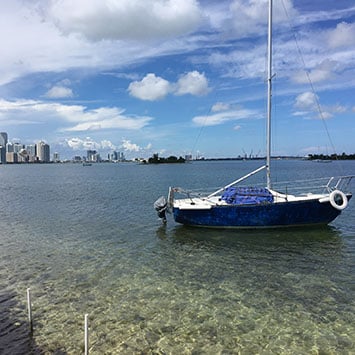A Rising Tide Drowns a City | Miami
Can nature help save a city from drowning?
Sea level rise is not a dystopian vision of the future in Miami. It is happening now.
Neighborhoods across the city become inundated with salt water each year between September and November during unusually high tidal events known as king tides. Sometimes called “sunny day flooding,” this phenomenon occurs commonly on clear days without a drop of rainfall in sight.
Sea levels in South Florida have risen 8 inches over the past century, increasing 3 inches between 1992 and 2015 alone. With a projected rise of up to 7 feet, parts of the Miami area could be submerged by the end of this century.
Miami’s geology makes it especially vulnerable to flooding: the city is flat and low-lying, and it sits atop a layer of highly porous limestone, which allows seawater to push its way up into the city from below.
Miami and its neighboring municipalities have tried to battle sea level rise with traditional engineering methods. The City of Miami Beach has raised streets, constructed massive seawalls, and installed pumping stations.
But organizations such as Frost Science Museum’s Museum Volunteers for the Environments (MUVE) are taking a more natural approach to defend the city.
MUVE has been restoring native dune and mangrove habitats on Virginia Key Island, where volunteers have planted sea oats and red mangrove trees and removed invasive plant species such as Australian pines. These natural features provide barriers against high tides and storm surges.
“The problem is in a city like Miami that’s grown so fast, we’ve removed a lot of this natural protective element, and we’ve put in sea walls,” said MUVE Director Fernando Bretos. “Once the water has breached a sea wall, it’s no longer a protective element. That’s not the case with dunes and mangroves. They can withstand the salt water and keep functional during a storm. We’re trying to bring more back and basically fighting fragmentation. And it’s very hard to plant a dune on a sea wall; it just doesn’t work.”
Behind the dunes on Virginia Key lies the Central District Wastewater Treatment Plant. Having natural dune and mangrove buffers on the island could potentially shield the facility during a flood or storm surge, preventing sewage waste from washing into Biscayne Bay.
Keeping the bay free of pollutants in the face of sea level rise can be difficult in the densely populated Miami metropolitan area, where salt water can inundate abandoned industrial sites, residential septic systems, and dirty city streets.
“We’re looking at our energy infrastructure, our waste water infrastructure, and our drinking water infrastructure all potentially failing to work in the not-too-distant future,” said Rachel Silverstein, executive director of the environmental advocacy group Miami Waterkeeper.
Miami’s drinking water is also vulnerable to the rising sea. The primary source of fresh water for South Florida is the Biscayne Aquifer, a 4,000-square-mile underground reservoir that runs directly beneath Miami-Dade County. Salt water has already begun to intrude into the aquifer.
As the city looks to shore up its freshwater supply, its most important natural asset may be the Everglades. A massive source of fresh water for the region, the Everglades replenishes the aquifer and creates outward pressure against the salt water invading from the east and south.
Restoring the natural freshwater flow from Lake Okeechobee south through the Everglades could improve the health of the aquifer and ensure a reliable water supply for South Floridians.
“Just knowing where we are now and knowing that the sea level continues to rise, we know that restoring the Everglades, taking more water from Lake Okeechobee, storing it, cleaning it, and sending it south, as opposed to just dumping it and wasting that water to tide , we can put that water to use,” explained Everglades Foundation Senior Ecologist Stephen Davis. “And not only for the habitats around us, but also for ensuring that we have a viable water supply for South Florida well into the future."
— Sean Keenehan






